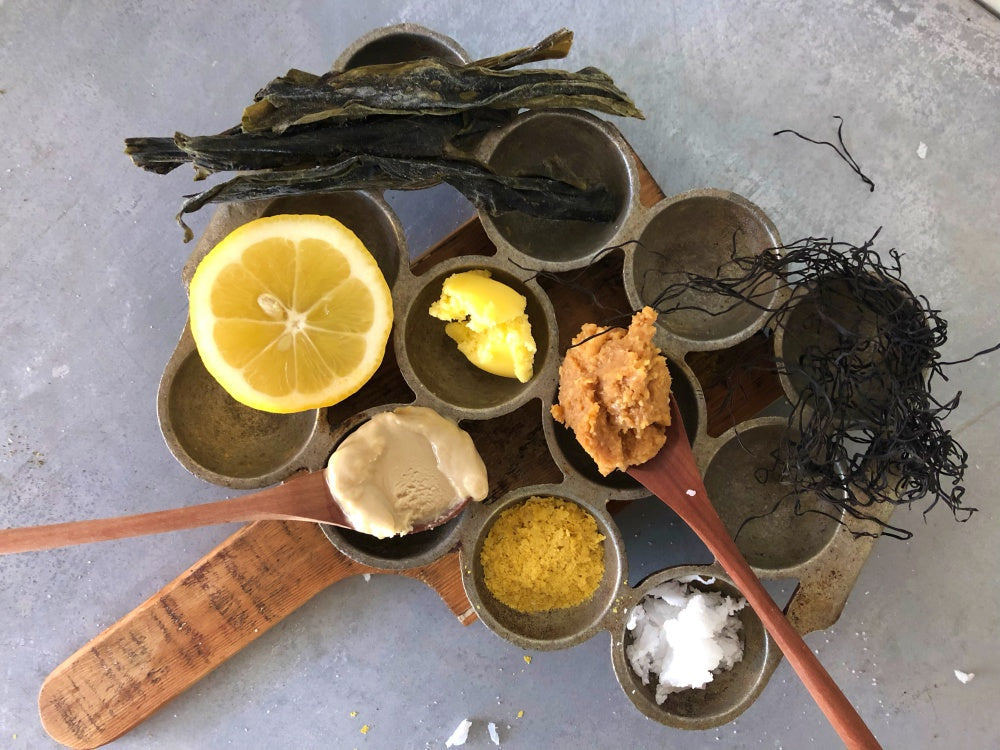Flavour and Balance
As you start making recipes from scratch you might come across unusual ingredients or some that are unfamiliar to you. We are not recommending you throw out what you have already, rather using up what you have and consider replacing items that run out with some of the healthy options we discuss below to add flavour and extra depth to your recipes. Some of the products we are going to discuss are readily available at supermarkets, but for others you may need to try health food shops or bulk food stores. Ingredients that were once difficult to find do seem to becoming more readily available as people become more adventurous and experiment with different styles of cooking.
Author of 'My New Roots' Sarah Britton describes the “holy trinity of flavour” as sugar, salt and acid. If any of your recipes taste bland, check that you have included all three. It seems counterintuitive but we often add a very small dash of a sweetener such as maple syrup to an otherwise savoury dish such as hummus or a dip and similarly a pinch of salt adds depth to sweet dishes. The flavour of many soups can be balanced by adding acid in the form of lemon juice or dash of apple cider vinegar. If saltiness is the missing factor try adding a small amount of sea salt, tamari or miso paste.
Here is a good guide
- If your dish needs more depth of flavour, add umami (miso, tamari) or salt
- If your dish is too spicy or too sour, add a sweetener or fat (coconut cream, almond butter, oil)
- If your dish is too sweet, add fat, heat (a pinch of cayenne pepper works wonders) or sour (lemon, vinegar)
Salty Ingredients
Salt - Firstly, avoid table salt as it may contain anti caking agents. Our pantry favourites are Himalayan salt or Celtic sea salt which both contain more minerals than table salt. Try and vary the type of salt you use each time you need to replenish your pantry as salts that come from different regions have a different profile of minerals. As with any ingredients, try and find salt from a source that is as pristine as possible as many sea salts these days have been harvested from contaminated oceans and many actually contain microplastics. Salt flakes are great for garnishing sweet treats, specially those containing caramel or chocolate.
Tamari - is a type of soya sauce and great for people who are gluten intolerant as the brewing process doesn’t usually use wheat (but still check the label to be sure!). It goes well in stir fries, marinades, dressings and dipping sauces, or anywhere else that you might use soya sauce and is a great way to add salt and depth of flavour to your dishes.
Sea Vegetables - examples include arame, dulse, wakami and kelp. Usually purchased in dry form, add a salty savoury flavour and are high in vitamins and minerals, iodine. As for anything coming from our increasingly polluted oceans, make sure any products are sourced from a pristine environment.
Oils and Fats
As a general rule aways look for oils that are cold pressed, extra virgin, unrefined and where possible, organic.
Olive oil
Beware of “light” oils or blends as these may be mixed with refined seed oils such as canola or sunflower to create a cheaper product. Avoid imported olive oil for the same reason. Olive oils will vary according the region in which they were grown, the variety and stage of ripeness of the olives. If you are interested in finding out all about Australian olive oil here is a great podcast.
Sesame oil - is supposedly one of the most stable oils, buy only when cold-pressed. Adds a delicious flavour to Asian dishes.
Flax seed oil - has a slightly bitter taste and can go rancid quickly so is best stored in the fridge. Has many health benefits and can be used in salad dressings but avoid heating it for cooking.
Hemp seed oil - has a perfect ratio of omega 6:3 fats making it extremely good for you. Like flax seed oil, don’t use it for cooking and store in the fridge.
Pumpkin seed oil - has a lovely green colour and looks pretty impressive drizzled as a garnish over soups and dips. It is a rich source of essential fatty acids but again, best not used for cooking.
Coconut Oil - coconut oil has many health benefits - such as being high in medium chain fatty acids, being anti-viral and anti- fungal, and is useful for helping to solidify recipes. It can sometimes have an overpowering coconut flavour in desserts in particular so some people prefer to use the refined, flavourless and odourless versions available. You might notice your jar will become liquid in summer and solidify again as weather cools down. For this reason, desserts containing coconut oil will need to be kept in the fridge or freezer. Coconut oil has a high smoke point so is very suited to cooking or frying.
Ghee -is made by clarifying butter and because of its very high smoke point, is very suited to cooking at high temperatures. It also adds a beautiful caramel like flavour and is stable at room temperature in cooler months.
Miso
Miso is a paste traditionally made by fermenting soya beans, but now available made from a variety of other legumes such as chickpeas. It is rich in probiotics and adds a real flavour boost to recipes. Available in many colours - white, yellow and red usually depending on the length of fermentation. The darker the colour the stronger the flavour will be, with the mildest flavour being white and the most robust being red. Miso has a slightly salty flavour and like all fermented foods, adds a complexity of flavour to recipes sometimes referred to as umami. Look for the varieties that are in the fridge at health food shops or speciality supermarkets as these are typically unpasteurised, retaining beneficial bacteria and enzymes.
Nutritional Yeast Flakes
Nutritional yeast is sometimes called “nooch” and adds a savoury cheese like flavour to dishes. It is widely used to add flavour to non dairy based cheeses and dips. It is made from deactivated yeast grown on molasses and is high in B vitamins, especially B12 which is lacking in some diets.
Tahini
Tahini is a good source of protein, calcium and a variety of minerals and vitamins. It is a paste made from ground roasted sesame seeds and if you like to make things from scratch, try making your own by following the recipe in our last newsletter for seed butters. It has a rich, nutty flavour and lends itself to both sweet and savoury recipes. We love it in granolas and slices to help bind ingredients but you could also mix it with lemon juice and yoghurt for a delicious creamy dressing. Tahini is available as both hulled (having the outer husk removed) and unhealed which is less processed, darker in colour and with a more bitter flavour.
Apple Cider Vinegar
This is fermented from apple cider and the best brands are those containing “the mother”. ACV is great to use in salad dressings, stocks, sauces or when you want to add a dash of acid to balance flavours.
Pantry Tips
- When lemons are plentiful juice them, freeze in ice cube trays then store in a zip lock bag or container in the freezer. You have a stash of lemon juice in the freezer when lemons are $2 each at the supermarket, and often imported! We do the same for other citrus so we always have orange juice for example on hand when the only offerings in fruit shops are imported from California.
- If you have been adventurous and made our roasted almond nut butter from last week and are concerned about having too much on hand, or if you made a very large batch, this can also be frozen in ice cube trays for longer term storage.
- Store your oils in a cool dark cupboard to maintain freshness. Some oils are best stored in the fridge (See above)

